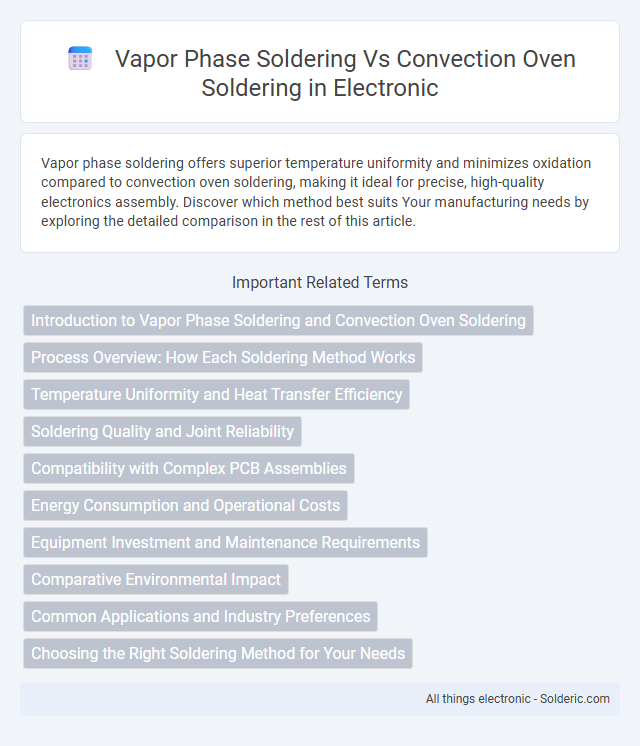Vapor phase soldering offers superior temperature uniformity and minimizes oxidation compared to convection oven soldering, making it ideal for precise, high-quality electronics assembly. Discover which method best suits Your manufacturing needs by exploring the detailed comparison in the rest of this article.
Comparison Table
| Aspect | Vapor Phase Soldering | Convection Oven Soldering |
|---|---|---|
| Heating Method | Condensation of vaporized liquid on PCB | Hot air circulation around PCB |
| Temperature Control | Precise, uniform at vapor temperature | Less uniform, depends on airflow |
| Thermal Stress | Low, gentle heating ramp | Higher, potential hotspots |
| Process Speed | Fast, stable temperature profile | Variable, slower due to airflow balance |
| Process Atmosphere | Inert vapor environment | Air, possible oxidation |
| Applications | Complex, sensitive PCB assemblies | General PCB soldering |
| Equipment Cost | Higher initial investment | Lower cost, simpler setup |
| Energy Efficiency | High, due to phase change heat transfer | Moderate, relies on forced air circulation |
Introduction to Vapor Phase Soldering and Convection Oven Soldering
Vapor phase soldering uses a saturated vapor to uniformly transfer heat, enabling precise temperature control and reducing thermal stress on components during soldering. Convection oven soldering relies on heated air circulation to solder, which can lead to less uniform heat distribution and potential temperature variations across the PCB. Understanding the differences in heat transfer methods helps optimize your soldering process for improved reliability and efficiency in electronics assembly.
Process Overview: How Each Soldering Method Works
Vapor phase soldering uses a heated vapor for uniform heat transfer, where a saturated liquid evaporates to create a consistent temperature environment that melts solder precisely. Convection oven soldering circulates hot air over the PCB, relying on forced airflow to transfer heat and reflow solder paste through gradual temperature ramping. Your choice depends on the need for uniform heating in vapor phase versus the flexible temperature profiling found in convection ovens.
Temperature Uniformity and Heat Transfer Efficiency
Vapor phase soldering ensures superior temperature uniformity by utilizing saturated vapor to evenly transfer heat across components, minimizing thermal shock and reducing hotspots. In contrast, convection oven soldering relies on heated air circulation, which can lead to temperature gradients and less consistent heat distribution. Your choice of vapor phase soldering enhances heat transfer efficiency, achieving precise, uniform soldering results ideal for sensitive electronic assemblies.
Soldering Quality and Joint Reliability
Vapor phase soldering provides superior thermal uniformity and consistent heat transfer, resulting in higher soldering quality and fewer defects compared to convection oven soldering. This process minimizes thermal stress on components, enhancing joint reliability and reducing the risk of solder joint failure. When ensuring the longevity and robustness of your electronic assemblies, vapor phase soldering is often the preferred choice for critical applications.
Compatibility with Complex PCB Assemblies
Vapor phase soldering excels in compatibility with complex PCB assemblies due to its uniform heat transfer and precise temperature control, reducing the risk of thermal stress and component damage. Compared to convection oven soldering, which can create uneven heating and cold spots on densely populated boards, vapor phase soldering ensures consistent solder joints even on multi-layer or high-density PCBs. Your complex assembly's reliability benefits from the enhanced thermal uniformity and reduced oxidation provided by vapor phase soldering processes.
Energy Consumption and Operational Costs
Vapor phase soldering typically consumes less energy than convection oven soldering due to its efficient heat transfer mechanism using a boiling liquid medium, which reduces heating time and temperature variability. Operational costs are lower with vapor phase soldering since it minimizes thermal stress on components and requires less maintenance, whereas convection ovens often need longer cycle times and more frequent calibration. Choosing vapor phase soldering can optimize your production efficiency by lowering energy expenses and extending equipment lifespan.
Equipment Investment and Maintenance Requirements
Vapor phase soldering requires higher initial equipment investment due to specialized condensers and precise temperature controls, but offers lower long-term maintenance costs thanks to fewer moving parts and less airborne contamination. Convection oven soldering typically involves more affordable equipment upfront but demands regular maintenance to clean fans, filters, and heating elements, increasing operational expenses over time. Your choice should balance upfront investment against ongoing maintenance needs to optimize production efficiency and cost-effectiveness.
Comparative Environmental Impact
Vapor phase soldering significantly reduces emissions of volatile organic compounds (VOCs) compared to convection oven soldering, making it a more environmentally friendly option. The closed-loop system in vapor phase soldering minimizes heat loss and energy consumption, resulting in lower greenhouse gas emissions. Convection ovens typically consume more electrical energy and can release more airborne pollutants, increasing their overall environmental footprint.
Common Applications and Industry Preferences
Vapor phase soldering is commonly utilized in aerospace, medical devices, and high-reliability electronics manufacturing due to its precise temperature control and minimal thermal stress. Convection oven soldering is preferred in mass production environments such as consumer electronics and automotive industries for its cost-effectiveness and faster throughput. Industry preferences often favor vapor phase soldering where component sensitivity demands, while convection ovens dominate applications requiring scalability and speed.
Choosing the Right Soldering Method for Your Needs
Vapor phase soldering offers precise temperature control and even heat distribution, making it ideal for sensitive components and complex assemblies, while convection oven soldering provides faster processing and higher throughput suitable for mass production. Your choice depends on factors like component sensitivity, production volume, and quality requirements. Evaluating these aspects ensures the selected method aligns with your manufacturing goals and product reliability standards.
Vapor phase soldering vs convection oven soldering Infographic

 solderic.com
solderic.com